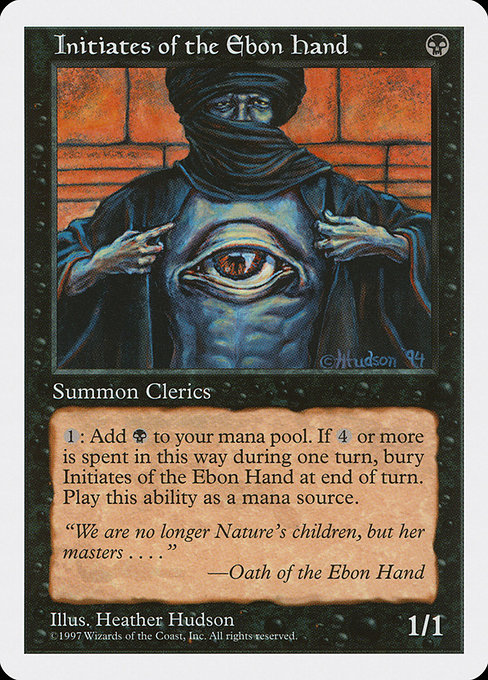
Image courtesy of Scryfall.com
Why this character matters in MTG canon
From the earliest days of color identity, Magic's black mana has always thrived on a dance between cost, payoff, and a healthy dose of risk. Initiates of the Ebon Hand is a perfect microcosm of that ethos. A humble 1/1 Cleric for B, it looks like a nothing card at first glance—and that’s precisely the point. For a single black mana, you get a creature that can generate another black mana every time you activate its ability. The catch? if you push this engine too far, you’ll be offering the Ebon Hand’s tainted gift back to the cosmos at the start of the next end step. This is black as a character study: a devotion to power with a price tag that shows up not as a big spell, but as a steady, creeping tempo engine. 🧙♂️🔥💎
The card’s mana mechanic—"{1}: Add {B}. If this ability has been activated four or more times this turn, sacrifice this creature at the beginning of the next end step."—is a distinctive early example of a “mana dork” that doubles as a risk-reward engine. It isn’t the flashy, multi-mana payoff we later associate with the color, but it whispers a larger truth about MTG’s canon: black often extends its reach through cunning, sacrifice, and repetition. Each activation drinks a little more from the well, building toward a bigger plan, while the looming side effect keeps the pressure honest. That tension is a throughline in many black-creature designs across the years. ⚔️🎲
A lore-forward lens: the Oath and the Ebon Hand
“We are no longer Nature's children, but her masters . . . .” —Oath of the Ebon Hand
The flavor text anchors Initiates of the Ebon Hand in a broader, eerie narrative arc. The Ebon Hand as an organization in MTG lore embodies a philosophy that pushes beyond nature toward domination and mastery—an appetite that resonates with black’s long-standing themes of ambition, control, and ritual. This little creature is a seed of that worldview: a humble apprentice who grows into a tool for potent black strategies, all while tethered to a ritualized end that echoes the cultish flavor of the oath. In canon terms, it’s a reminder that even low-cost, low-stature entities can be connected to grand, dark ambitions. 🎨🧙♂️
Impact on deck design and game history
In practice, Initiates of the Ebon Hand lived most of its life in the shadow of the broader black archetypes of the era. As a common 1-drop from Fifth Edition (1997), it offered early players a way to accelerate black mana in a low-curve shell—and it did so with a self-imposed governor: the more you squeezed out of those activations, the faster you approached the creature’s sacrifice. It foreshadowed later designs where a card’s value isn’t just what it does on the battlefield, but what it asks you to do with it in the near term. For limited play, the card provided a reliable little engine that could pave the way for backbreaking plays if you kept the tempo in your favor—yet it would grit its teeth and vanish if you pushed too far. In the broader MTG timeline, those early experiments with risk-reward mana sources helped shape how designers think about “temporal engines” and the cost of power in black’s wheelhouse. 💎⚔️
Art, aesthetics, and collector perspective
Heather Hudson’s illustration for Initiates of the Ebon Hand captures the austerity and menace of a cleric who might be found at the edge of a ritual circle. The white border era of Fifth Edition gives the card a classic look that many collectors cherish, especially given its reprint history and place in the game’s early mythos. The artwork and flavor text together invite players to imagine the character’s inner dialogue as the mana builds—one more step toward whatever shadowy rite the Ebon Hand intends. The card’s rarity is common, a reminder that not all iconic MTG pieces are reserved for the most powerful decks; some of the game’s most enduring moments thrive in the unglamorous corners of the card pool. 🧙♂️🎨
Design lessons we still feel today
Initiates of the Ebon Hand stands as a compact manifesto for early-metalanguage design: a small body that seeds a larger plan, a cost that keeps the engine honest, and a flavor-rich setting that fans instantly recognize. It’s a card that teaches new players to read the board not just for what’s on it, but for what the card asks you to do with your future turns. The balance between resource generation and self-imposed timing constraints mirrors many modern design decisions: how to reward proactive play without becoming oppressive, and how to embed narrative texture into mechanics so color identities stay vivid across decades. 🧙♂️🔥💎
As modern MTG evolves, we still see echoes of this historical moment in the way black continues to probe the line between growth and sacrifice, between a plan and the cost of its execution. Initiates of the Ebon Hand isn’t just a nostalgic artifact; it’s a quiet advocate for the idea that a single, well-crafted creature can unlock a world of strategic possibilities when the timing—and the lore—are right.
Blue Abstract Dot Pattern Tough Phone CaseMore from our network
- https://blog.digital-vault.xyz/blog/post/calibrating-photometry-for-a-blue-hot-star-at-23-kpc/
- https://blog.digital-vault.xyz/blog/post/anarchy-deck-tech-videos-influencers-debating-mtg-chaos/
- https://blog.digital-vault.xyz/blog/post/ghoulraiser-illustrations-reveal-modern-mtg-art-evolution-trends/
- https://blog.digital-vault.xyz/blog/post/astrometric-parallax-illuminates-a-distant-blue-star-in-sagittarius/
- https://blog.digital-vault.xyz/blog/post/third-data-release-sharpens-the-cosmic-distance-ladder-from-a-hot-giant/